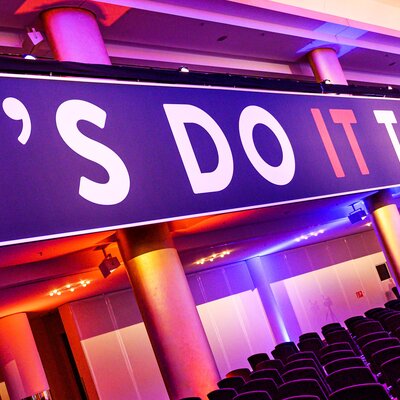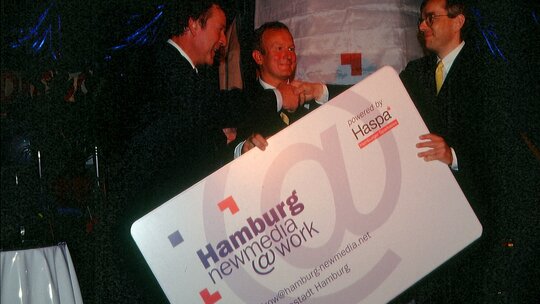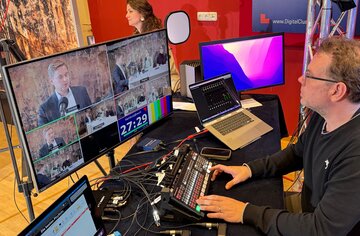
Mach mit bei Hamburg@work
Mit einer Registrierung bleibst du auf dem Laufenden, auch ohne Mitglied zu werden. Einmal registriert zahlst du einen Obulus pro Veranstaltung. Für registrierte Studierende und Auszubildende halten wir eine begrenzte Anzahl an Freitickets bereit. Mit einem Mitgliedsbeitrag für 12 Monate sind Selbstständige und Freiberufler sowie Mitarbeitende von Unternehmen dauerhaft dabei. Wir setzen auf Thought Leadership durch Vernetzung und Überzeugung mit Expertise, Ideen und Meinungen ohne direkte werbliche Botschaften. Interessant? Dann bring dich ein!
Zukunft durch Networking
Zukunft durch Networking
Sei dabei bei einem der ältesten Cluster-Netzwerke Deutschlands
Eine Mitgliedschaft bei Hamburg@work öffnet die Tür in ein großes branchen- und clusterübergreifendes Netzwerk. Dabei schaffen wir eine vertrauensvolle und intensive Zusammenarbeit im gesamten Netzwerk von Hamburg@work, in unseren eigenen Netzwerken im Netzwerk und in vielen Branchenclustern auf überregionaler und internationaler Ebene.
Wo alles begann

Wo alles begann
Alles begann zu Zeiten der Dotcom-Blase mit einem einzigen Veranstaltungsformat das Geschichte geschrieben hat. Das Treffen der Hamburger onlineKapitäne, war „der“ Branchentreff der jungen digitalen Medienszene. Bis zum Platzen der Blase wuchs die Veranstaltung auf unglaubliche 1.200 Teilnehmer an. Als das Museumsschiff Cap San Diego im Hamburger Hafen nicht mehr genügen Platz bot, wechselten wir in den alten Kaispeicher A, dem Sockel der heutigen Elbphilharmonie, die sich mit einem gläsernen, an Segel erinnernden Aufbau aus dem alten Speicher erhebt.
Hamburg@work trägt das GOLD Label der EU
Im Unterschied zu regionalen oder nationalen Cluster-Förderprogrammen ist das „Cluster Organisation Management Excellence Label GOLD“ ein unabhängiges und freiwilliges Prädikat für Spitzenleistungen im Clustermanagement, das in ganz Europa anerkannt ist.
Das erlebt ihr bei Hamburg@work
Hamburg@work bietet Networking pur auf Veranstaltungen, Weiterbildung durch Webinare und Informationen zu neuen Arbeitsmodellen, Erfahrungsaustausch berufliche Vernetzung durch regelmäßige Events in verschiedenen Formaten, Sichtbarkeit seiner Mitgliedsunternehmen, soziales Engagement sowie Preisvorteile bei Veranstaltungen von Kooperationspartnern.
Gerne laden wir auch zu Live-Events mit guter Musik und kulinarischen Köstlichkeiten an der Elbe oder auf der Cap San Diego ein. Denn so bringt Hamburg@work seit mehr als 28 Jahren die richtigen Menschen zusammen, an den richten Orten, zur richtigen Zeit und im dazu passenden Ambiente.
Und immer dabei sind fachliche Beiträge in allen Formen moderner Kommunikation (Live, Webseite, Newsletter, PodCast, VideoCast, Social, etc.). Wichtig ist uns nur, dass es sich um Fachbeiträge oder andere Formen der Kompetenzvermittlung handelt und keinesfalls um werbliche Inhalte.

Hamburg@work Studio
Im Rahmen von People & Culture sprechen wir darüber, wie Unternehmen ihre Resilienz stärken können, dadurch innovativer und leistungsfähiger werden und so dem ständigen Wandel in dieser Zeit erfolgreich begegnen können.
Female Leadership und Diversity sind zwei wichtige Säulen von People & Culture. Zu diesen Themen stellen wir erfolgreiche Konzepte und Maßnahmen von Menschen und Unternehmen vor, lassen Experten und Expertinnen zu Wort kommen und gehen mit unseren Mitgliedsunternehmen in den Austausch.
AI.HAMBURG ist eine Initiative, die von den Smaato Gründern Petra Vorsteher & Ragnar Kruse initiiert und gemeinsam mit Hamburg@work und städtischen Partnern ins Leben gerufen wurde. Unser gemeinsames Ziel ist die Adaption von Artificial Intelligence in Unternehmen und Start-ups zu beschleunigen, Ausbildung und Weiterbildung zu fördern und ein führendes Ökosystem für die Anwendung künstlicher Intelligenz aufzubauen.
Unsere Hamburger IT-Strategietage haben sich längst zu einem nationalen Leitkongress für CIOs entwickelt und bestätigen seit 2002 jedes Jahr im Februar erneut ihre Vorreiterrolle als Deutschlands bevorzugte Konferenz für Top-IT-Entscheider anwendender Unternehmen. Seit 2022 ergänzen wir das Programm mit einem mehrtägigen IT-Strategietage Masterclass Summit im Sommer. Alle Veranstaltungen werden in Partnerschaft mit Faktor 3 Live, Computerwoche und CIO Magazin durchgeführt.


